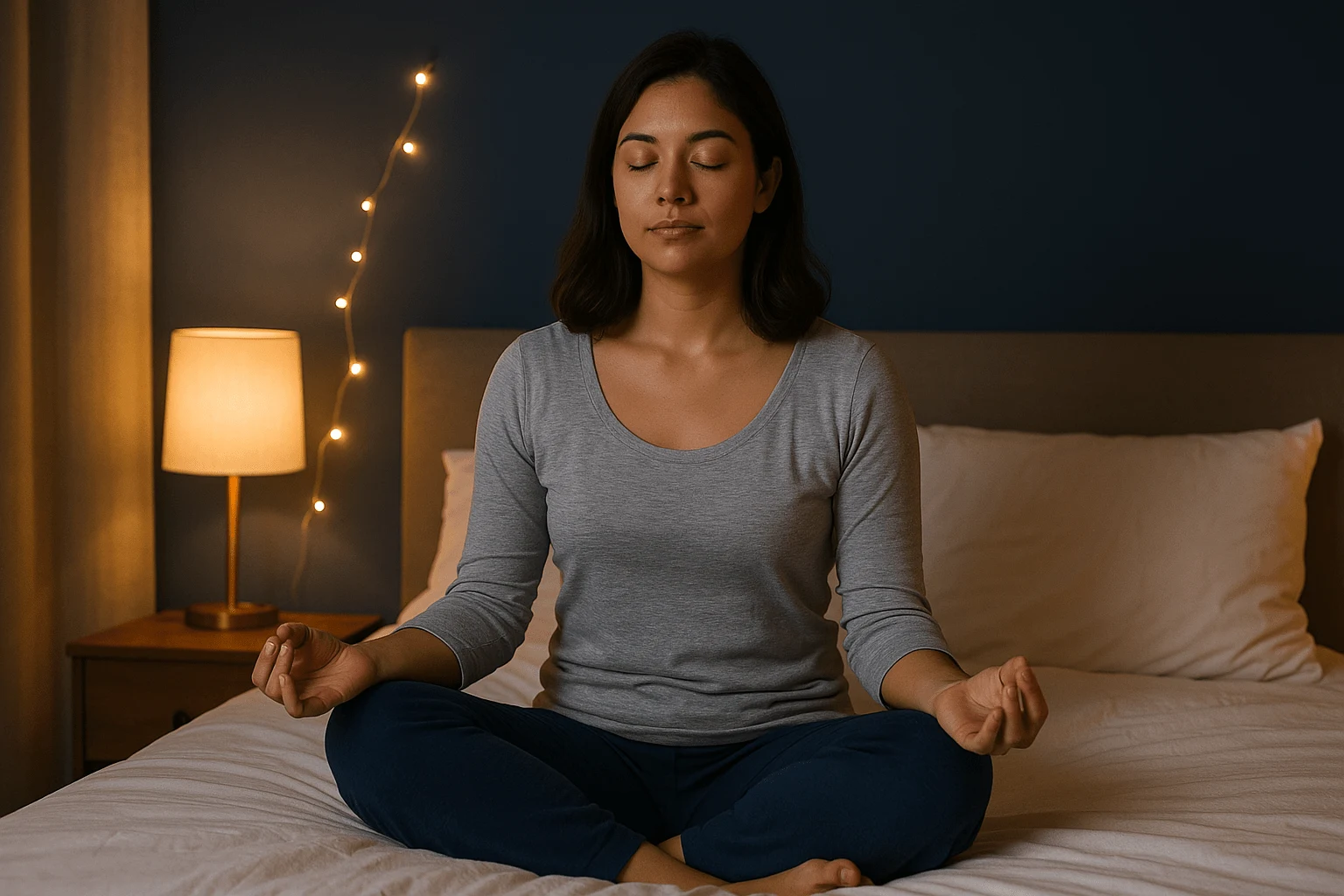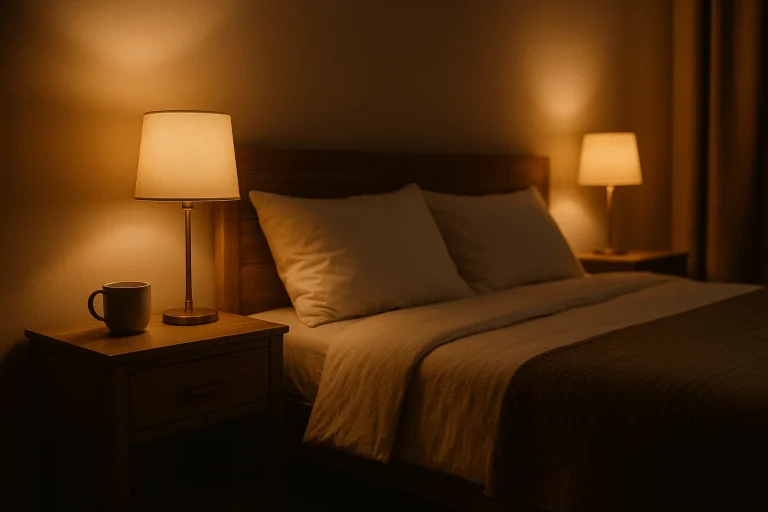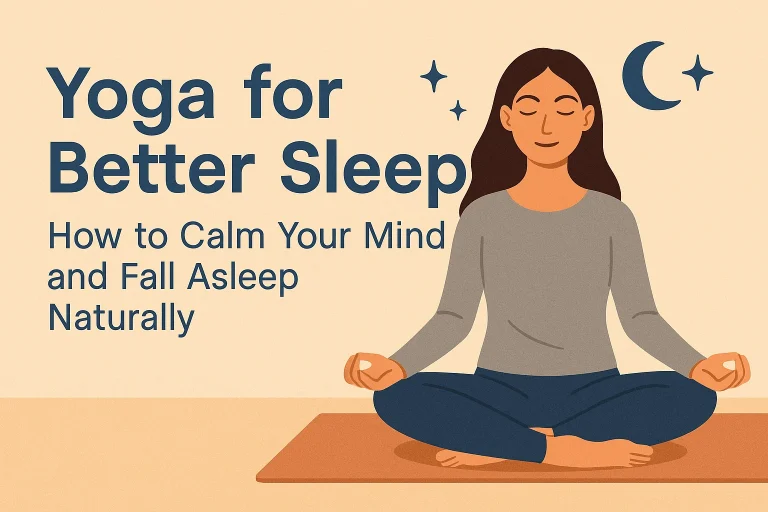How to Use Meditation for Sleep: The Step-by-Step Guide to Deep, Restful Nights
For so many of us, sleep isn’t just about closing our eyes. It’s about shutting off the endless mental chatter, quieting that low hum of anxiety, and finding a sense of calm that doesn’t always come naturally—especially in today’s world of overstimulation, late-night scrolling, and high-stress living.
If you’ve ever felt like you’re doing everything right—cutting out caffeine, keeping the room cool, even avoiding screens—and you’re still tossing and turning, you’re not alone. And here’s where something surprisingly simple can make a huge difference: meditation for sleep.
Not the sit-on-a-mountain, humming-for-hours type of meditation. We’re talking about short, guided, science-backed techniques that help your body and your mind slow down, relax, and drift off without a struggle.
In this post, we’re diving into:
- What science really says about how meditation improves sleep
- Step-by-step methods you can use tonight (even if your brain is wired)
- Common mistakes that make meditation less effective
- And how sleep meditation doesn’t just help you snooze—it can change how you show up in the world the next day
Whether you’re brand new to mindfulness or you’ve tried it before and it “didn’t work,” this guide’s got you covered—with expert advice, gentle guidance, and zero judgment.
You’re just a few minutes away from learning how to create a peaceful, sleep-ready mind. Let’s begin.
The Science Behind Meditation for Better Sleep

Let’s get one thing straight: meditation isn’t just spiritual fluff or something reserved for monks in mountain caves. It’s a scientifically proven tool that helps quiet the mind, relax the body, and—yes—improve sleep.
But how exactly does it work?
How Meditation Helps Calm the Brain Before Bed
When you’re lying in bed staring at the ceiling, your brain can feel like it’s in overdrive—thinking about work, to-dos, or why you said that awkward thing three days ago.
This is where meditation for sleep comes in. It helps shift your brain out of “go-go-go” mode and into “rest-and-digest” mode by activating the parasympathetic nervous system—your body’s natural calming response.
Instead of ruminating, your mind gets gently guided toward stillness. And with that shift? Your body follows, relaxing muscles, slowing your heart rate, and letting you ease into sleep.
Meditation’s Effect on Cortisol and Stress Hormones
You’ve probably heard of cortisol—that sneaky little hormone responsible for stress, racing thoughts, and late-night restlessness. When cortisol levels are high, falling asleep can feel like trying to nap on a rollercoaster.
Research shows that mindfulness meditation reduces cortisol levels, especially when practiced consistently at night. A 2015 study published in JAMA Internal Medicine found that adults who practiced mindfulness had significant improvements in sleep quality compared to those who followed standard sleep hygiene tips.
So no, it’s not in your head. Meditation literally lowers the hormones that keep you wired.
Does Meditation Really Help You Sleep?
Short answer? Yes. But here’s the slightly longer one:
Studies have shown that meditation improves sleep latency (how long it takes you to fall asleep), reduces nighttime awakenings, and even increases deep sleep cycles. People with insomnia who practice meditation regularly report better sleep quality, less daytime fatigue, and greater overall well-being.
And the best part? The effects are cumulative. The more you practice, the more your brain rewires itself to handle stress better—and rest deeper.
How to Meditate for Better Sleep: A Step-by-Step Bedtime Routine
Let’s be honest—when you’re exhausted but wired, even the idea of how to meditate can feel overwhelming.
But here’s the truth: meditating for sleep doesn’t need to be perfect, long, or complicated. You don’t need incense. You don’t need to sit cross-legged. You just need a quiet moment and a little guidance.
Here’s a simple, beginner-friendly flow to help your body unwind and your mind let go.
How to Fall Asleep with Meditation: A Simple Nighttime Flow That Works
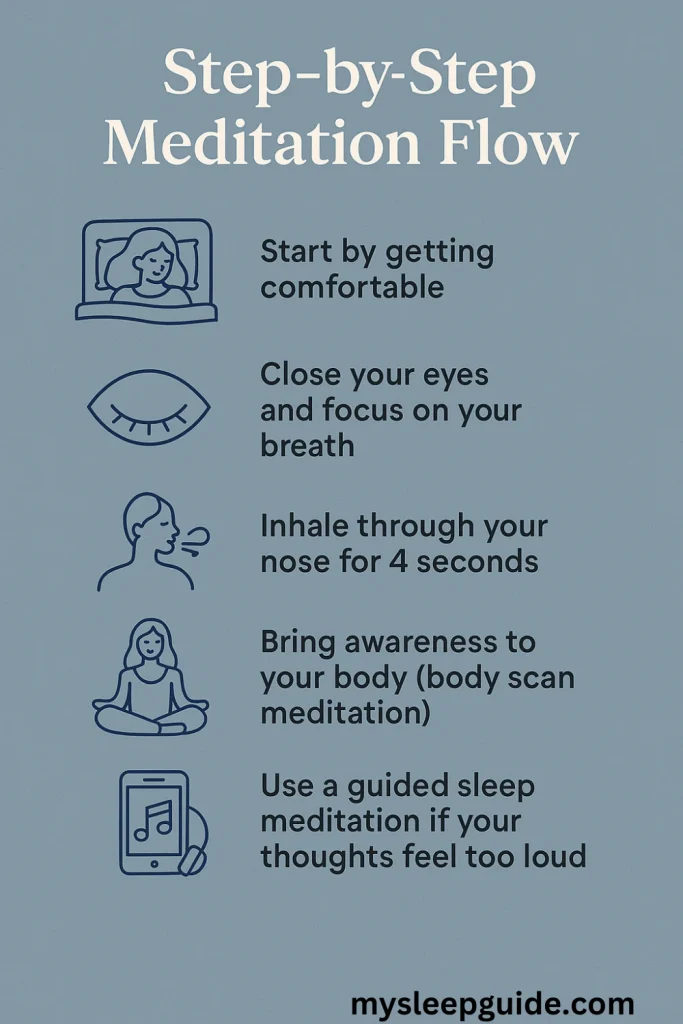
If you’re lying in bed, eyes closed, but your thoughts are louder than ever—you’re not alone. Here’s how to use meditation to actually fall asleep:
Step 1: Get Comfortable
- Lie on your back or side in bed—whatever feels most natural.
- Dim the lights, silence your phone, and turn off any screens.
- Optional: Light a calming candle or spritz a bit of lavender spray.
- Let your body settle into stillness—no pressure, just presence.
Step 2: Focus on Your Breath
- Inhale through your nose for a count of 4 seconds
- Hold your breath for 4 seconds
- Exhale slowly through your mouth for 6 seconds
- Repeat this pattern for 2–3 minutes to calm your nervous system and slow your heart rate.
Step 3: Do a Body Scan
- Begin at your toes, and mentally “check in” with each part of your body.
- As you move upward, release tension from each area—feet, legs, hips, chest, shoulders, jaw, eyes.
- This gentle awareness triggers the relaxation response, signaling to your body that it’s safe to sleep.
Step 4: Try a Guided Sleep Meditation
- If your thoughts are racing, don’t fight them—guide them.
- Use a meditation app like Insight Timer, Calm, or Headspace.
- Search for phrases like:
- “Drift into sleep”
- “Let go of the day”
- “Guided body scan for sleep”
Step 5: Let Go of the Outcome
- Here’s the secret: don’t try to fall asleep.
- Ironically, trying too hard often keeps your brain alert.
- Instead, let the meditation itself be the goal—and trust that sleep will follow naturally.
→ Pro Tip: Keep your eyes closed even if you’re “not asleep yet.” The brain still rests in a meditative state.
Choose the Right Type of Nighttime Meditation
Not all meditations are sleep-friendly. Some are energizing (great for mornings), while others are calming and meant to gently guide you into rest.
Here are five proven techniques to help you wind down and sleep deeper:
- Body Scan Meditation – Gently moves attention through your body from head to toe, helping you notice and release hidden tension.
🎧 Try this 14-Min Body Scan for Sleep (UCLA)
(Free, science-backed, calming tone)
- Mindful Breathing – Focused, slow breathing that steadies your nervous system and quiets mental noise. Simple but powerful.
🎧 5-Minute Breathing for Sleep (Insight Timer)
(Perfect for beginners, free with app login)
- Visualization – Picture a peaceful scene—like a cozy cabin in the woods, floating on a calm lake, or lying in a warm field under the stars.
🎧 Guided Visualization: Peaceful Forest
(Relaxing visuals and narration—great if you’re a visual thinker)
- Yoga Nidra – Known as “yogic sleep,” this method brings you into a state between wakefulness and sleep. Incredibly restorative and often guided.
🎧 30-Min Yoga Nidra for Deep Sleep
(One of the most calming styles out there—don’t be surprised if you fall asleep halfway through
- Loving-Kindness Meditation (Metta) – A soothing practice of sending gentle wishes of well-being to yourself and others. It helps release emotional tension and promotes a sense of inner peace—especially helpful if you’re going to bed with heavy thoughts.
🎧 Loving-Kindness for Sleep (UCLA MARC)
(Gentle and compassionate—ideal for easing anxious or heavy thoughts before bed)
→ Not sure where to start? Try a different one each night this week and notice which one makes you feel the calmest. Your ideal sleep meditation is the one that works for you, not the one that sounds best on paper.
Related: 7 Powerful Breathing Exercises for Better Sleep You Can Try Tonight
Why Meditation Might Not Be Working for You (And How to Fix It)
You’ve downloaded the app, put on the sleep sounds, followed the voice…
And you’re still lying there, wide awake, wondering if you’re doing something wrong.
First of all—you’re not.
Meditation isn’t magic. And when it comes to sleep, there are a few common traps that can make it feel like it’s not working.
Let’s break them down—and more importantly, show you how to fix them.
Common Mistakes That Make Sleep Meditation Backfire
Here are some sneaky habits that can sabotage your meditation without you realizing:
❌ Trying Too Hard to Fall Asleep
When you meditate just to fall asleep, your brain may stay on high alert, waiting for results.
This creates pressure—and pressure is the enemy of rest.
⏳ Being Inconsistent
Doing a guided sleep meditation once in a while won’t retrain your brain.
Like exercise or brushing your teeth, it’s the habit that brings long-term results.
🧘 Using the Wrong Type of Meditation
Some practices—like chanting, energizing breathwork, or morning affirmations—are stimulating.
What you need before bed are slow, calming nighttime meditation techniques like body scan or mindful breathing.
🔊 Meditating in a Stressful Environment
Even the best meditation can’t override a bad setup.
Bright lights, screen notifications, a noisy room, or an uncomfortable bed can make it hard to relax—no matter how “zen” your audio is.
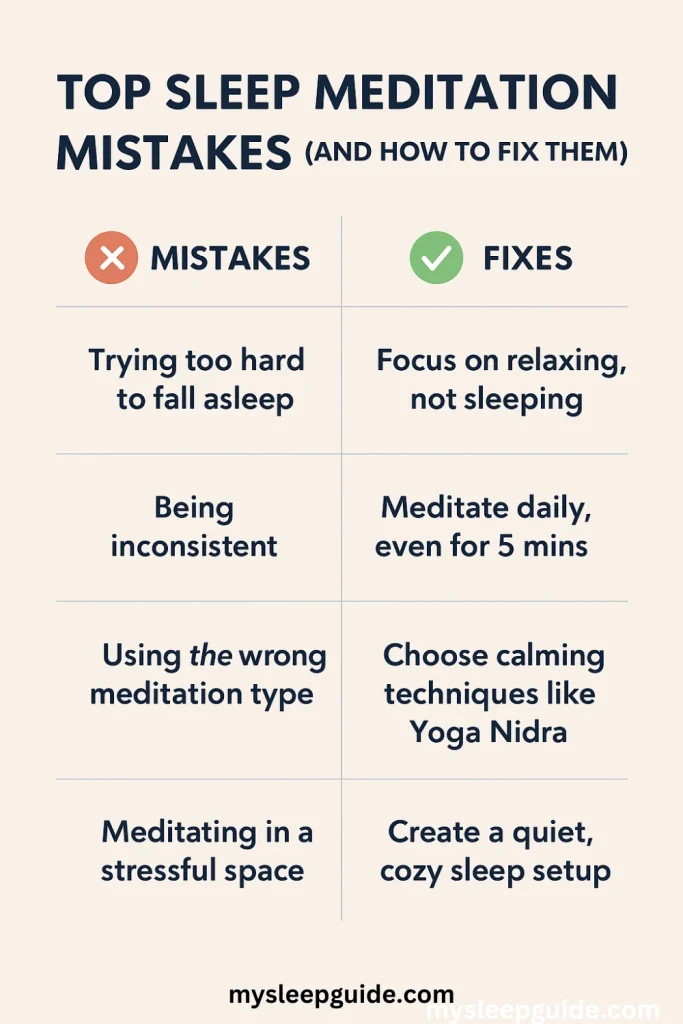
Related Post: This is How Sleep Affect Your Immune System
Is Your Brain Too Wired? Try These Fixes
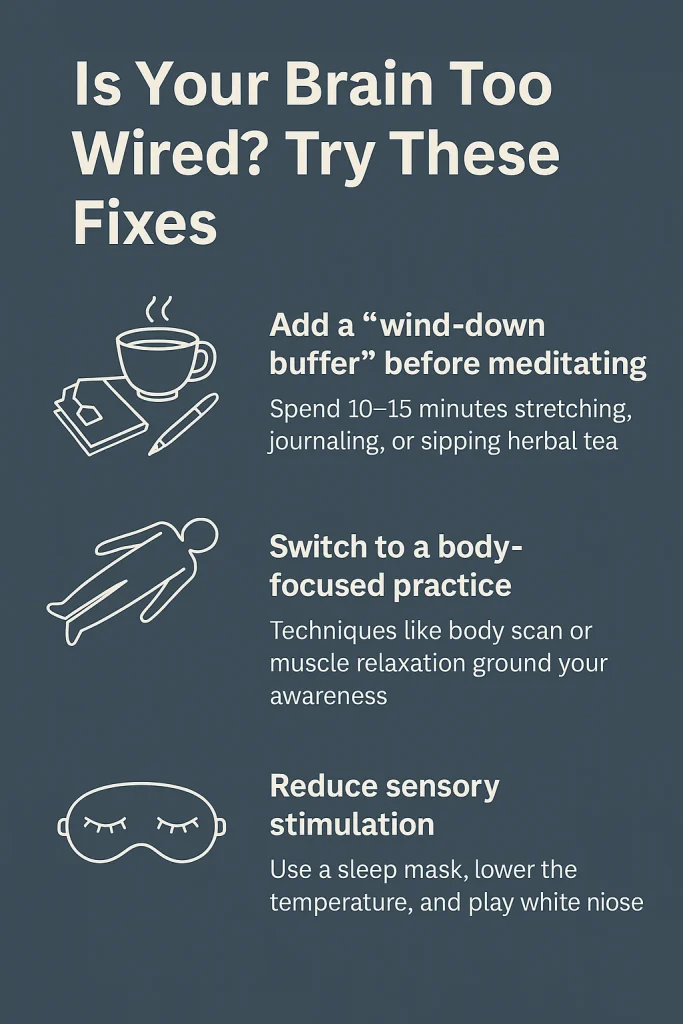
If your mind feels like a hamster on a caffeine binge, try these tweaks to ease into the right headspace:
– Add a “wind-down buffer” before meditating.
Spend 10–15 minutes doing light stretching, journaling, or sipping herbal tea before hitting play on your guided meditation. This signals your body that it’s safe to shift into rest mode.
– Switch to a Body-Focused Practice
If your thoughts feel like a runaway train, get out of your head and into your body.
Techniques like body scan or progressive muscle relaxation can anchor your awareness and pull you away from mental noise.
– Reduce Sensory Stimulation
Overstimulation = restlessness.
Try:
- Wearing a sleep mask
- Cooling your bedroom to around 65°F (18°C)
- Using white noise, soft music, or calming sleep sounds to create a restful atmosphere
When It’s Not You—It’s Your Sleep Environment
Sometimes, it’s not the meditation at all—it’s your setup. Here’s what to check:
– Cut Out Blue Light Exposure
Screens suppress melatonin, your sleep hormone.
Turn off TVs, tablets, and phones at least 30–60 minutes before meditation to give your brain a fighting chance to unwind.
– Eliminate Disruptions
Even low-level noise or flashing lights can interfere with relaxation.
Try these:
- Earplugs or white noise machines
- Blackout curtains
- A “do not disturb” sign (if needed) 😄
– Get Comfortable with Your Posture
Forget the lotus pose—you’re not in yoga class.
You can meditate lying down in bed. Just make sure you’re:
- Properly supported (pillows under knees or neck if needed)
- Warm enough
- In a position that feels safe and still
Reset Your Approach: What to Do Instead
If meditation hasn’t worked yet, don’t ditch it—just adjust the approach.
Here’s what often helps:
- Focus on relaxing—not sleeping.
The less you chase sleep, the more likely it will come naturally. - Try shorter sessions first.
A 5-minute guided session can be just as effective as 30, especially for beginners. - Pair meditation with a soothing ritual.
Create a “sleep playlist” that includes guided meditation, soft music, and a gratitude practice.
Meditation is a practice, not a performance. If it hasn’t worked for you yet, you’re not failing—you’re still learning.
Stick with it. Adjust what needs adjusting. And trust that your body knows how to rest when you give it the space to do so.
Related : 5 Proven Mental Exercises That Help You Sleep Better
🌙 Final Thoughts
If sleep has been slipping through your fingers lately, you’re not alone—and you’re not broken.
You’ve just been operating in a world that doesn’t make rest easy. But the good news? You already have everything you need to change that.
Meditation for sleep isn’t about perfection. It’s about permission.
Permission to slow down.
Permission to breathe.
Permission to rest—without pressure or performance.
Whether you start with a guided body scan, a few minutes of mindful breathing, or just turning off your phone and sitting with your thoughts, you’re building a bridge back to better sleep. And that’s something worth showing up for.
So tonight, instead of dreading the toss-and-turn routine, try something different.
✨ Light a candle.
✨ Get cozy.
✨ And give yourself a few quiet minutes to just be.
Your mind may resist at first. That’s okay. It’s learning. You’re learning.
And with a little patience and consistency, sleep won’t feel like a struggle—it’ll feel like coming home.
What About You?
Have you tried meditating before bed?
What’s helped you quiet your mind at night?
Share your experience in the comments—your story might help someone else sleep a little better too.
❓Frequently Asked Questions About Meditation for Sleep
Q: How do I meditate for sleep if I’m new to it?
Start simple: just breathe and relax. You don’t need to sit cross-legged or chant mantras. Lie down, close your eyes, and begin with slow, intentional breathing:
- Inhale for 4 seconds
- Hold for 4 seconds
- Exhale for 6 seconds
You can also try a guided sleep meditation like a body scan or visualization. The goal isn’t to force sleep—it’s to create calm. Sleep will follow.
Q: Does meditation help with sleep?
Yes, meditation helps improve sleep. It reduces cortisol (the stress hormone), slows your heart rate, and activates the relaxation response. Research shows it can help people fall asleep faster, stay asleep longer, and experience deeper rest.
Q: Can meditation reduce the need for sleep?
Meditation doesn’t replace sleep—but it supports it. While meditation can help you feel more rested, it doesn’t provide the same physical recovery as deep sleep. Use it as a powerful supplement, not a substitute.
Q: What kind of meditation is best for sleep?
Calming, slow-paced meditations are best for sleep. These include body scan meditation, mindful breathing, Yoga Nidra, and guided sleep visualizations. Avoid stimulating techniques before bed.
Q: Can I meditate lying down in bed?
Yes, you can meditate while lying in bed. In fact, it’s often the most natural way to prepare for sleep. Just ensure you’re comfortable, supported, and free from distractions like lights or phone alerts.

